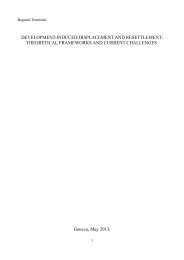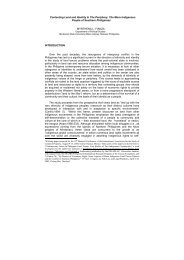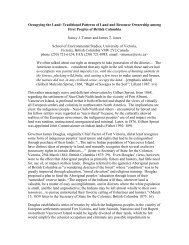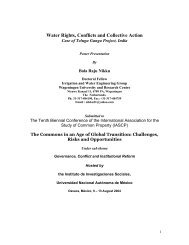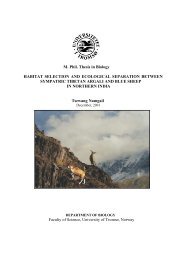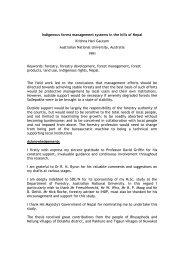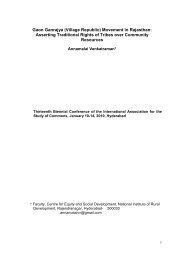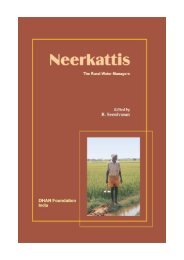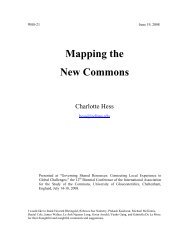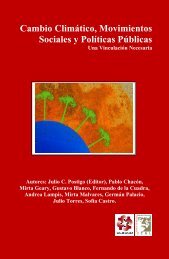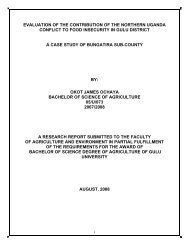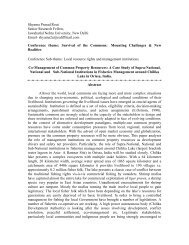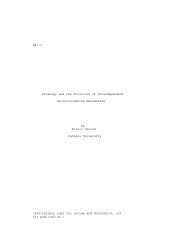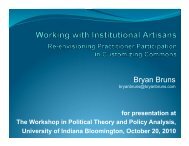Legal empowerment for local resource control
Legal empowerment for local resource control
Legal empowerment for local resource control
Create successful ePaper yourself
Turn your PDF publications into a flip-book with our unique Google optimized e-Paper software.
104<br />
BOX 8. TRANSNATIONAL TORT LITIGATION<br />
A strategy that may be used to overcome some of the legal constraints<br />
concerning domestic litigation (lack of legal aid, standing issues, lack of<br />
judicial independence, low levels of compensation, etc.) is to bring a lawsuit<br />
(not against the <strong>local</strong> subsidiary be<strong>for</strong>e domestic courts, but) against the<br />
parent company in its home country (transnational litigation). The<br />
effectiveness of this strategy depends on the law in <strong>for</strong>ce in the home<br />
country.<br />
In the UK, the possibility of such a strategy was opened by the Spiliada case,<br />
in which the pre-existing “<strong>for</strong>um non conveniens” doctrine (whereby courts<br />
should refuse to hear a case if they are satisfied that the courts of another<br />
country are a more appropriate <strong>for</strong>um) was qualified by an exception –<br />
where the court feels that “substantial justice will not be done in the<br />
alternative <strong>for</strong>um”. This exception was applied in Connelly and in Lubbe v.<br />
Cape – both concerning lawsuits to parent companies <strong>for</strong> damage caused by<br />
their subsidiaries abroad. In both cases, lack of legal aid in the host country<br />
would have meant that substantial justice could not be done (on these cases,<br />
see Muchlinski, 2001; and Ward, 2001).<br />
In the US, transnational lawsuits have been brought under the Alien Tort<br />
Claims Act (ATCA) of 1789, which gives US courts jurisdiction over civil tort<br />
actions brought by <strong>for</strong>eigners <strong>for</strong> acts “committed in violation of the law of<br />
nations” – even if these acts occurred abroad. In the Filartiga case, a US court<br />
held that it had jurisdiction to hear cases concerning violations of<br />
international (human rights) law. Since then, a number of lawsuits have been<br />
brought in the US, concerning primarily human rights violations (see e.g. Doe<br />
v. UNOCAL) but also, more rarely, environmental torts (Aguinda v. Texaco – in<br />
which, however, the court dismissed a lawsuit concerning oil pollution<br />
committed by a US-<strong>control</strong>led company in Ecuador).<br />
While the approaches followed by UK and US law differ in various respects<br />
(e.g., application of ordinary tort law in the UK vs need to link the lawsuit to<br />
a violation of international law in the US), they do, potentially, open the door<br />
to litigation <strong>for</strong> damage to property caused by <strong>for</strong>eign investment projects.<br />
However, important constraints exist, from both a legal and an extra-legal<br />
point of view – which explains the very limited number of successful cases<br />
brought so far.<br />
From a legal point of view, a first challenge is meeting the test to establish<br />
home country jurisdiction (e.g., in the UK, the two-pronged Spiliada test).<br />
This may be more difficult in the US than in the UK – as plaintiffs would be<br />
required to show that damage to property violated a norm of international<br />
law. Beyond the jurisdiction issue, a key challenge is the “corporate veil” –<br />
legally, the parent company and the subsidiary are separate entities. In order



